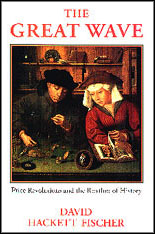By David Hackett Fischer
Oxford University Press
536 pages
 Now that we have had relatively low inflation in the United
States for more than a decade, it may seem time to celebrate
the end of high inflation and claim that we know how to keep
inflation permanently in check. But this new book by David
Hackett Fischer suggests that we should be less sanguine about
our understanding of inflation and our ability to control
it.
Now that we have had relatively low inflation in the United
States for more than a decade, it may seem time to celebrate
the end of high inflation and claim that we know how to keep
inflation permanently in check. But this new book by David
Hackett Fischer suggests that we should be less sanguine about
our understanding of inflation and our ability to control
it.
Fischer believes that economists are too shortsighted about inflation, that we try to get our understanding of inflation and monetary policy only from our experience of the last 40 or 50 years. He also believes that we are shortsighted in thinking, as Milton Friedman put it, that "inflation is always and everywhere a monetary phenomenon."
Instead, Fischer looks at the history of prices in Europe over the last 800 years to show that inflation has broader social causes than just increases in the money supply and that inflation has a devastating effect on social stability. Fischer examines four periods of prolonged inflation in European history: the first, beginning in the late 12th century; the second, beginning in the 15th century; the third, beginning in the early 18th century; and the modern period of inflation, starting in the 1890s. In each of these periods, inflation was preceded by widening income inequality and reductions in real wages for most people. As inflation proceeded in each episode, income inequality became greater and social unrest increased. Each episode of inflation was followed by a crisis: sometimes plague, sometimes war, sometimes revolution. After the crises in earlier centuries, an equilibrium of relatively stable prices, decreased income inequality and increased social stability prevailed.
The great strength of this book is to show the social pressures that led to inflation and inflation's devastating social consequences. We already know, for example, how the hyperinflation in Germany during the 1920s sowed the seeds of Nazism. But Fischer shows that the Hundred Years' War, the Thirty Years' War, and the American and French revolutions were largely caused by prolonged inflation.
Fischer does an admirable job of showing how population pressure caused increased income inequality in advance of long periods of inflation in earlier centuries. For example, in both the 13th and 16th centuries, population pressures in Europe led to farmers using fields that had lain fallow for hundreds of years. With more labor needing land, wages fell and rents rose, leaving most peasants impoverished, malnourished, and vulnerable to disease and invaders.
Fischer does not present any theory relating population pressures and income inequality to sustained increases in inflation before this century. Here is one plausible explanation: At the same time that farmers started cultivating fallow fields, other laborers saw increased opportunities for mining. As real wages went down, it became worthwhile to mine silver and gold from mines that had been previously abandoned, as well as to discover and develop new mines. In fact, both Fischer and other authors have commented on the great flurry of mines opened in the 1300s and 1500s, precisely when the cost of mine labor was very low. This increased mining produced new precious metal, and with the flood of that precious metal to market, prices rose. Thus population pressure increased the return to mining, which increased the money supply, eventually causing inflation.
This argument seems to explain inflation through the beginning of this century, and seems in agreement with Fischer's evidence. However, the causes of modern inflation are very different from the causes of the historic inflations described by Fischer. Arthur Rolnick and Warren Weber of the Federal Reserve Bank of Minneapolis have recently shown that during the past 60 years among developed countries, long-term growth in the money supply is an almost perfect predictor of long-term inflation ["Money, Inflation and Output under Fiat and Commodity Standards," forthcoming, Journal of Political Economy, December 1997]. Certainly, political pressures causing and preventing inflation differed among countries. But besides understanding those pressures, we don't need to look for any deeper explanation of modern inflations than the decisions of governments to increase money growth.
The lasting contribution of The Great Wave is to remind us of the devastating consequences of inflation. Fischer's work should reinforce our vigilance at the Fed to continue the policies that have kept inflation low over the past decade.





